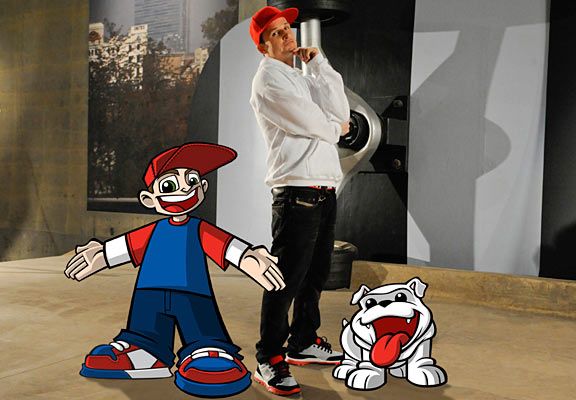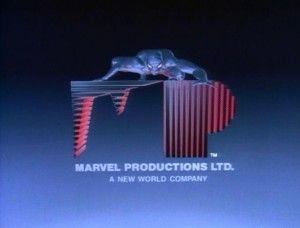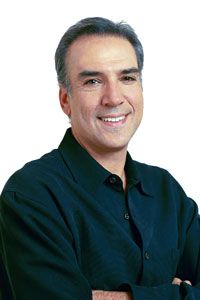The animation business has changed substantially in the past decade. While once syndicated series built on salable toy franchises ruled the after-school hours, today niche cable networks and DVD markets have cartoons fractioning between pre-school educational shows, outrageous comedy cartoons and more grownup-friendly action-adventures. And one person who's been with the medium through all of it is Bill Schultz.
As CEO of his own Home Plate Entertainment, Schultz is producing a number of animated projects for cable and on-demand channels, although his history with the form stretches back to the '80s when he worked at the earliest incarnation of Marvel Productions – the West Coast version of the iconic comic book company that produced everything from Transformers to Muppet Babies. From there, Schultz went on to work for several years with animation powerhouse Film Roman on a variety of cartoons, including the award-winning Bobby's World as well as a stretch on iconic primetime series The Simpsons.
With his latest series Wild Grinders, Schultz and Home Plate have teamed with reality TV star Rob Dyrdek and Nicktoons for kid-friendly skateboarding adventures. Spinoff Online spoke with Schultz about how his history from pitching superhero series alongside Stan Lee through working on primetime hits like The Simpsons has affected his view of the business at Home Plate and beyond.
SPINOFF: Bill, let's start in the present before we dive into your very packed history with animation let’s talk about your vision for your new company Home Plate Entertainment. What kinds of projects are you most interested in pursuing?
Bill Schultz: Home Plate is a studio which is primarily an animation studio. What makes it a studio is that we identify great stories and market-driven ideas and properties which we can develop into great entertainment and content, and we can develop, finance, produce, and distribute that content in all media, across all platforms, with a focus on animated or family content. But just like everything else in our world, that is going to change!
Going back -- you worked on a TON of shows in your career, starting with your first animation stint with Marvel Productions in the '80s. What's your memory of the company then when you worked with Stan Lee and Margaret Loesch (now head of The Hub – the new Hasbro-Discovery kids' cable network)?
Well, of course, I worked for Marvel "Animation," which was based here in Los Angeles, as opposed to the comic book part of the company, based in New York. Although he was based here in Los Angeles, Stan worked for both the comic book and the animation company. It’s hard to believe but I remember the days when we would pitch Spider-Man to NBC as a Saturday morning kids show and the network wanted no part of it. Spider-Man was irrelevant to kids. I mean this is Stan Lee himself – go figure. We also had amazing artists like Will Meugniot, Larry Houston, Rick Hoberg, Frank Parr – really great directors and comic book artists doing X-Men and Marvel Super Hero development and pilots – and nobody wanted it. It wasn’t until the X-Men animated series on Fox, or the big Spider-Man movies came along later that the market for Marvel characters and Stan Lee were of real value. It just shows how things can change in this business.
While at Marvel, you worked on two franchises near and dear to comic and sci-fi fans hearts during their formative years: Transformers and G.I. Joe: A Real American Hero. What do you make of the way those franchises have been revitalized as major film franchises with so much of the story DNA created by the Marvel talent back then?
Marvel Animation produced all of these Hasbro Toy properties for Hasbro’s advertising agency’s production company Sunbow. The incredible animation talent at Marvel brought all of these shows to the American audience in bulk. It’s interesting that most of the animation on these shows was done in Japan at Toei before it became too expensive and the animation moved to Korea. But the style was set in part by Marvel for sure and the creative integrity and Anime DNA built into these toy-driven shows by the “Hollywood meets Japanese” animation techniques is the reason that these brands have the fan base they have today. Marvel also produced Jim Henson’s Muppet Babies, for which the studio won a ton of Emmys. It was the number one series on Saturday morning, which back then was just CBS, ABC and NBC.
Through the '80s and '90s, you produced a multitude of shows, first at Marvel and then for almost ten years at Film Roman, including comic strip-based shows like Garfield & Friends and Mother Goose & Grimm and well known properties – The Mask, Richie Rich, Felix the Cat, Bobby’s World and Tom & Jerry – not to mention cultural touchstone The Simpsons and other primetime series like King of the Hill and the short-lived The Critic. What are your personal favorites and highlights from those days?
Clearly the highlight was having the opportunity to work with so many super talented, creative iconic people: Matt Groening, Stan Lee, Phil Roman, Jim Brooks, Joe Barbera, Mike Judge, Greg Daniels, Howie Mandel – it’s a long list – and these were all superstars of our industry, and having the chance to pitch gags and story ideas it was crazy. I remember Joe Barbera sitting and drawing Tom & Jerry thumbnails – and then getting up and acting them out. Stan Lee is a great pitch man!
After you left Film Roman, you produced several series for Cartoon Network (Ed, Edd & Eddy, Courage the Cowardly Dog, etc.) and you also partnered with Welsh animator Mike Young in LA, selling half of your company to French animation studio Moonscoop. I think a lot of animation fans don't immediately think of France as a hotbed of popular, high-quality cartoons. What's the process like ultimately working in conjunction with European artists and creators as opposed to the model most are familiar with where pre-vis and writing work are done in LA and nuts and bolts animation was done in Asia?
It was the beginning of the globalization of the entertainment industry. In the old days you could be a successful independent animation producer – or any type of independent production company – and just rely on the U.S. market. But with the repeal of the Financial Syndication Interest Rule, which allowed the studios to own networks and the content they broadcast, it forced producers to look to the rest of the world as a market. Our partnership with France was a cultural and creative challenge. But ultimately knowing how to work in a truly collaborative production pipeline is what allows us to continue to develop and create new content. Most TV series animation is still done in Asia, due to cost. But the pre-production and development is done all over the world – anywhere where there are talented artists. Hollywood is still considered the most universal sense of storytelling, probably due to our immigrant history and melting pot of cultural ideas. But there are more and more exceptions every year, and many of the top programs on US television are products of other countries – whether it is The Office or Despicable Me – there are significant chunks of creative from all over the world. Americans are more and more open to international programs every day. Pokémon was not created here in Hollywood.
Animation has gone through a lot of changes since that time – the demise of syndicated animation market, the rise of the 24-7 niche programming cable networks (Nick, CN, Disney ,etc.) and now a growing market for Internet and On Demand channels like Kabillion, which you've been involved with. What's been the most consistent thing about producing and distributing animated cartoons for you? What's changed the most?
The most consistent thing is that great talent is the key to making good content. Technology has changed everything – the pipeline is all digital and so much more creative. But strong creative talent – artists, writers, directors, actors – is the most fundamental element of the industry, and I always strive to work with the most talented team the budget and schedule will allow! Ideas are important, but execution is all up to the crafts people bringing it to life. No matter what platform or medium, the key to a great project is great talent.
Like I said above, Home Plate Entertainment is currently your home ... I'm going to go with "base" instead of making some "plate" pun. And your most recent series is the new Nicktoons show Wild Grinders, which was created by and stars reality TV personality and skateboarder turned entertainment brand impresario Rob Dyrdek. How'd you hook up with Rob, and what's been the biggest part of launching a show like this for Home Plate?
Rob wanted to make an animated series for kids, inspired by his childhood skate crew, which he called the Wild Grinders. We pitched him on the idea that we could launch the concept with digital shorts while we were in development for the series. He liked the idea of the immediacy and creative freedom with the short format while we were figuring out how we were going to make the series. Originally, I had developed the show while still at Moonscoop, but I was able to continue the partnership with Rob and his team under the Home Plate Entertainment banner. The most challenging part was to set up a new studio and finance and produce a new series all at the same time. Although having produced so many series over the years, the key was lining up a great team and then just providing a blueprint – like a conductor with a great set of orchestrations. The show is a huge hit, and there is already talk of a second season. We had a great time and Rob and his Exec Producer (and character designer) Tracy Tubera are great to work with. The show is so funny and Rob, who does the voice of the main character Lil Rob, deserves an Emmy for his voiceover work on the series!
Wild Grinders seems like a very personality-driven show, not just as it features Rob's personal interests but also because you all seem to be working hard with the cast to stay diverse but not play to stereotypes and tokenism. What were the biggest challenges in finding that balance with the characters?
The characters are all based on people that Rob has skated with from the time he was an eleven year-old in Ohio to some characters you might find hanging around the Fantasy Factory! We even have his sister Denise, his Mother Patty, Dad Gene and of course Meaty – Rob’s British Bulldog, who is an amazing skateboarder. We are always sensitive to stereotypes in kids programming because we don’t want the kids modeling negative and harmful behavior. They are so impressionable at the younger age of the audience.
Looking forward, I know you've got other projects on tap for both the kids and pre-school market. What kind of shows are you looking to do in the future with Home Plate? Any chance of a return to action-adventure series?
Our second series, which just started post-production, is called Teenage Fairytale Dropouts. It is about the next generation of iconic fairytale characters – like the son of the giant from Jack and the Beanstalk or the daughter of the Tooth Fairy. But just like most teenagers, these kids are rebelling against their parents’ ways. For example, although Jeremiah is the son of the giant, he has not hit his growth spurt and does not want anything to do with "the blood of an Englishman." We also produced an animated short (Twistmas) for Moshi Monsters – the online kids gaming phenomenon. We also produced the American voiced version of a new series for the new Disney Jr., called Guess How Much I Love You, which was based on the very popular children’s book.
One of the shows I produced which I was very proud of was the new Adventures of He-Man for Cartoon Network and Mattel. Also while at Moonscoop I produced a very cool action show called Hero: 108, which currently is on five-days a week on Cartoon Network here in the US and all over the world in 150 countries. As far as straight action adventure, I love the genre, but with Marvel now owned by Disney and DC owned by Warner Bros., there really isn’t too much demand for independently produced action shows. I don’t think of Bakugan or Monsuno as action shows, but if they sell enough toys – you never know!



